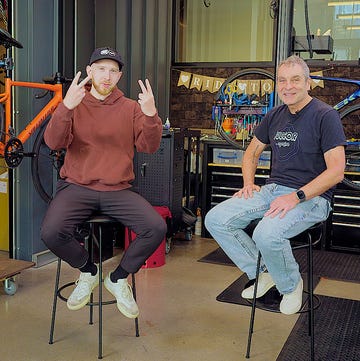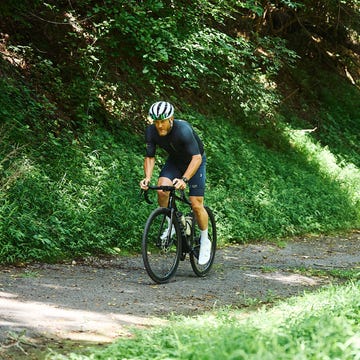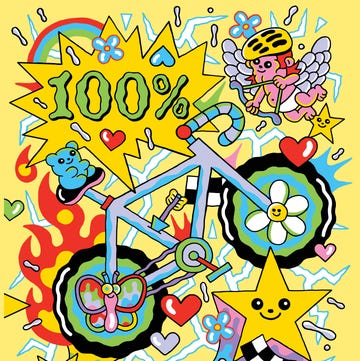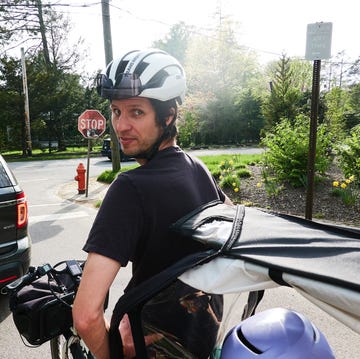On the return drive from Illinois, somewhere on I-80 in central Pennsylvania, Bikini Kill played loudly over the speakers. My friend Rachel lowered the volume, glanced at me, and asked, “What would you have changed about your bike setup?”
Rachel knew something was stirring in my head about the previous day’s race. “My big ring,” I fired back without hesitation. That answer led to a 90-minute conversation on gearing, cadence, sprinting, and watts before our dinner stop.
A few days before leaving for my summer trip to Intelligentsia Cup—10 consecutive days of races held each July in Chicagoland—I swapped out the Shimano Ultegra drivetrain on my crit bike in favor of a SRAM Force group. And from the moment I crossed the finish line of my last race 30 hours prior, that decision gnawed at me.
As I waited for Rachel and Kelly to return with platters of Eastern European food, I pulled up the legendary Sheldon Brown gear calculator on my phone. I stared at the results yet again for reassurance. According to the calculations, a 52x11-tooth gear—the largest on a standard Shimano 12-speed drivetrain—is two gear inches smaller than the 48x10T of most SRAM AXS-equipped road bikes, the combo that I used.
Although by then I had looked at the gear charts so often that I’d committed the undeniable numbers to memory, there was also no denying that, while I was riding, SRAM’s 48-tooth option didn’t feel as big as the Shimano 52. It seemed, in fact, dramatically smaller, especially on straightaways and long, flat road sections. And the rational side of my cycling brain cannot live with the dissonance of knowing that my gut and intuition have this one wrong.
Racing Intelli wasn’t the first time I’ve experienced this sensation when riding a smaller-sized big ring. It’s usually the first thing I notice when I ride a bike with compact rings. And I opine on the topic to colleagues, on group rides, and to teammates. Some nod knowingly, but most riders say that they don’t experience it or that it doesn’t bother them.
This time I became obsessed with understanding why I experienced the feeling.
The entire week after returning from my road trip, I sought answers. I combed through past ride data on Strava. I contacted SRAM and Shimano. And I messaged about the topic with my former coach, emailed an Olympic cyclist, and discussed nuances of efficiency with a leading expert. Though nothing in my research neatly explained the disparity in the sensations of riding those rings, I did learn some additional details about making a drivetrain faster.
Two larger-sized cogs are indeed more efficient, for example. And crankarm stiffness also plays a role. But none of those variances are at a level perceptible to riders. Silca’s owner, Josh Poertner, told me, “No, we almost certainly can’t feel any of this stuff.” He explained that “the human threshold for ‘least noticeable difference’ is generally on the order of 10 percent change of a value.”
Yet, one thing I learned is that even top professional cyclists can be affected by what I’ll call the Gear-Placebo Effect. As Poertner jokingly said near the end of our discussion, “We’re all headcases, it turns out.” Maybe for you, this discrepancy arises from tires or air pressure; perhaps it’s sock height, bar width, or hood position. Some of us believe that nerding out on the details and intricacies of gear choices will make a difference. In the end, unless our quirks somehow affect other riders’ safety, who cares? For almost all of us, our livelihoods do not depend on performance, so why shouldn’t we use whatever makes us feel the best on the bike? Ride whatever you want.
As long as you understand that, to me, 52x11 is bigger than 48x10.
As Deputy Editor, Tara Seplavy leads Bicycling’s product test team; after having previously led product development and sourcing for multiple bike brands, run World Championship winning mountain bike teams, wrenched at renowned bicycle shops in Brooklyn, raced everything from criteriums to downhill, and ridden bikes on six different continents (landing herself in hospital emergency rooms in four countries and counting). Based in Easton, Pennsylvania, Tara spends tons of time on the road and trail testing products. A familiar face at cyclocross races, crits, and bike parks in the Mid Atlantic and New England, on weekends she can often be found racing for the New York City-based CRCA/KruisCX team. When not riding a bike, or talking about them, Tara listens to a lot of ska, punk, and emo music, and consumes too much social media.













